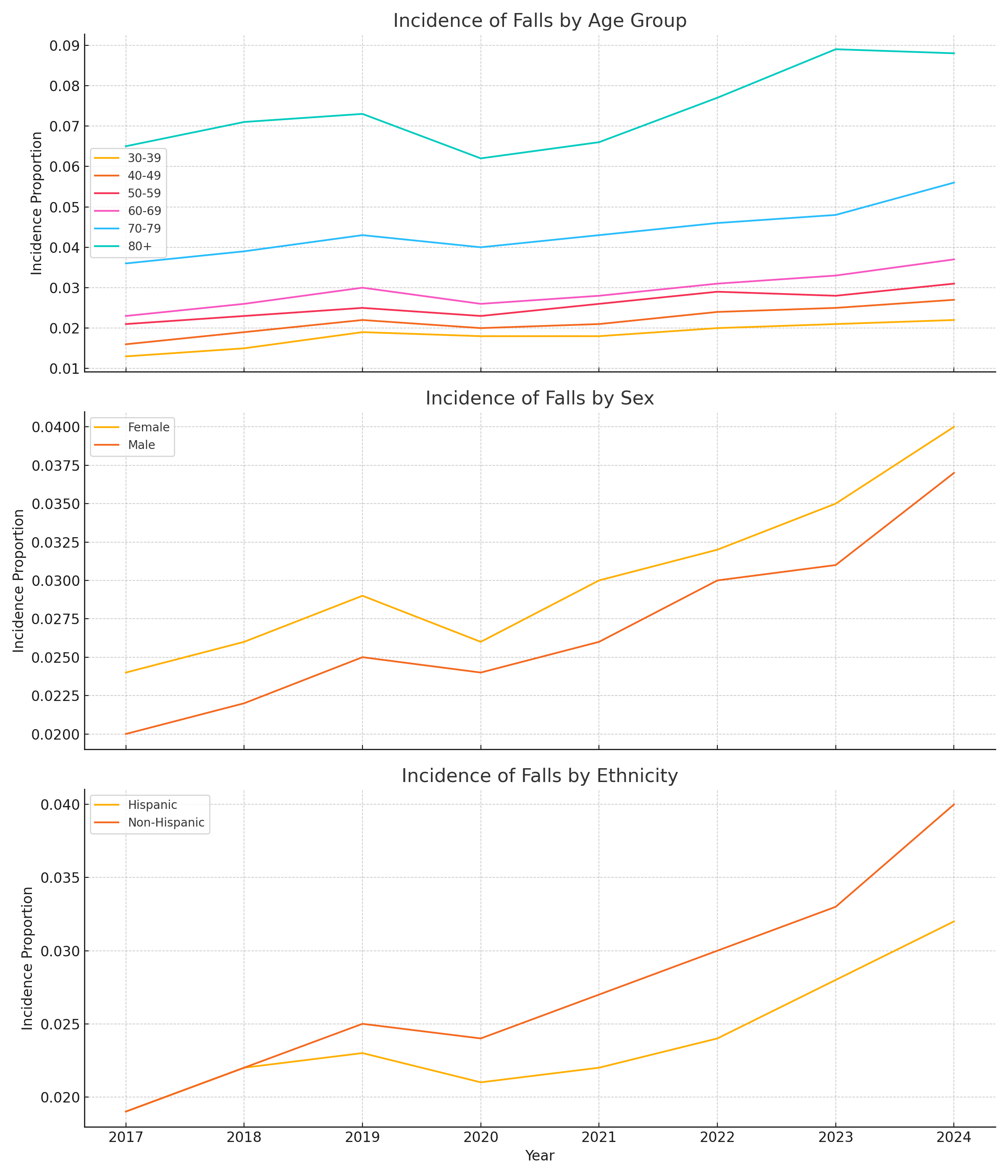Monday Poster Session
Category: Liver
P3665 - Increasing Incidence of Falls in Patients With Cirrhosis: A Multiyear Analysis From a National Real-World Dataset
Monday, October 27, 2025
10:30 AM - 4:00 PM PDT
Location: Exhibit Hall

Ashujot K. Dang, MD
University of California Riverside School of Medicine
Riverside, CA
Presenting Author(s)
Ashujot K. Dang, MD1, Vikash Kumar, MD2, Gautam Maddineni, MD3, Angad Mann, MD4, Manan Trivedi, MD5, Wael Youssef, MD2
1University of California Riverside School of Medicine, Riverside, CA; 2Creighton University School of Medicine, Phoenix, AZ; 3Florida State University, Cape Coral, FL; 4University of California Riverside School of Medicine, Rancho Cucamonga, CA; 5University of California Riverside School of Medicine, Redlands, CA
Introduction: Falls are a significant cause of morbidity in patients with cirrhosis due to frailty, hepatic encephalopathy, and sarcopenia. Despite their clinical importance, population-level data on fall trends in this population remain limited. We aim to analyze the trend of falls in patients with cirrhosis, along with identifying which age, ethnicity, or gender is at greater risk for individualized preventive strategies.
Methods: Using TrinetX US Collaborative Network we conducted a retrospective cohort study, identified adult patients >18 years (n=910,275) with cirrhosis, identified via ICD-10 codes for unspecified, alcoholic, and other cirrhosis from 2017 to 2024). Incidence and prevalence of falls were assessed annually using standardized diagnosis codes. Results were stratified by age, sex, race, and ethnicity.
Results: From 2017 to 2024, the incidence proportion of falls in patients with cirrhosis increased from 2.2% to 3.8%. The highest rates were observed in older adults, particularly those aged ≥85 years, whose incidence rose from 6.4% to 8.8%. Females consistently demonstrated higher fall incidence than males (4.0% vs. 3.7% in 2024). Non-Hispanic patients exhibited a greater increase in falls compared to Hispanic patients (4.0% vs. 3.2% in 2024). Racial disparities were evident, with Native Hawaiian or Other Pacific Islander and American Indian or Alaska Native individuals experiencing the highest fall rates. These findings indicate a growing and demographically patterned burden of falls in cirrhosis.
Discussion: This study reveals that the incidence of falls among patients with cirrhosis has increased substantially over the past eight years, particularly in older adults, females, and non-Hispanic populations. These findings highlight the urgent need for fall risk assessment and targeted prevention strategies in cirrhosis care, especially among individuals at higher risk among the cirrhotics.

Figure: Figure 1: Incidence trends of fall from 2017-2024 amongst patients with cirrhosis
Disclosures:
Ashujot Dang indicated no relevant financial relationships.
Vikash Kumar indicated no relevant financial relationships.
Gautam Maddineni indicated no relevant financial relationships.
Angad Mann indicated no relevant financial relationships.
Manan Trivedi indicated no relevant financial relationships.
Wael Youssef indicated no relevant financial relationships.
Ashujot K. Dang, MD1, Vikash Kumar, MD2, Gautam Maddineni, MD3, Angad Mann, MD4, Manan Trivedi, MD5, Wael Youssef, MD2. P3665 - Increasing Incidence of Falls in Patients With Cirrhosis: A Multiyear Analysis From a National Real-World Dataset, ACG 2025 Annual Scientific Meeting Abstracts. Phoenix, AZ: American College of Gastroenterology.
1University of California Riverside School of Medicine, Riverside, CA; 2Creighton University School of Medicine, Phoenix, AZ; 3Florida State University, Cape Coral, FL; 4University of California Riverside School of Medicine, Rancho Cucamonga, CA; 5University of California Riverside School of Medicine, Redlands, CA
Introduction: Falls are a significant cause of morbidity in patients with cirrhosis due to frailty, hepatic encephalopathy, and sarcopenia. Despite their clinical importance, population-level data on fall trends in this population remain limited. We aim to analyze the trend of falls in patients with cirrhosis, along with identifying which age, ethnicity, or gender is at greater risk for individualized preventive strategies.
Methods: Using TrinetX US Collaborative Network we conducted a retrospective cohort study, identified adult patients >18 years (n=910,275) with cirrhosis, identified via ICD-10 codes for unspecified, alcoholic, and other cirrhosis from 2017 to 2024). Incidence and prevalence of falls were assessed annually using standardized diagnosis codes. Results were stratified by age, sex, race, and ethnicity.
Results: From 2017 to 2024, the incidence proportion of falls in patients with cirrhosis increased from 2.2% to 3.8%. The highest rates were observed in older adults, particularly those aged ≥85 years, whose incidence rose from 6.4% to 8.8%. Females consistently demonstrated higher fall incidence than males (4.0% vs. 3.7% in 2024). Non-Hispanic patients exhibited a greater increase in falls compared to Hispanic patients (4.0% vs. 3.2% in 2024). Racial disparities were evident, with Native Hawaiian or Other Pacific Islander and American Indian or Alaska Native individuals experiencing the highest fall rates. These findings indicate a growing and demographically patterned burden of falls in cirrhosis.
Discussion: This study reveals that the incidence of falls among patients with cirrhosis has increased substantially over the past eight years, particularly in older adults, females, and non-Hispanic populations. These findings highlight the urgent need for fall risk assessment and targeted prevention strategies in cirrhosis care, especially among individuals at higher risk among the cirrhotics.

Figure: Figure 1: Incidence trends of fall from 2017-2024 amongst patients with cirrhosis
Disclosures:
Ashujot Dang indicated no relevant financial relationships.
Vikash Kumar indicated no relevant financial relationships.
Gautam Maddineni indicated no relevant financial relationships.
Angad Mann indicated no relevant financial relationships.
Manan Trivedi indicated no relevant financial relationships.
Wael Youssef indicated no relevant financial relationships.
Ashujot K. Dang, MD1, Vikash Kumar, MD2, Gautam Maddineni, MD3, Angad Mann, MD4, Manan Trivedi, MD5, Wael Youssef, MD2. P3665 - Increasing Incidence of Falls in Patients With Cirrhosis: A Multiyear Analysis From a National Real-World Dataset, ACG 2025 Annual Scientific Meeting Abstracts. Phoenix, AZ: American College of Gastroenterology.
